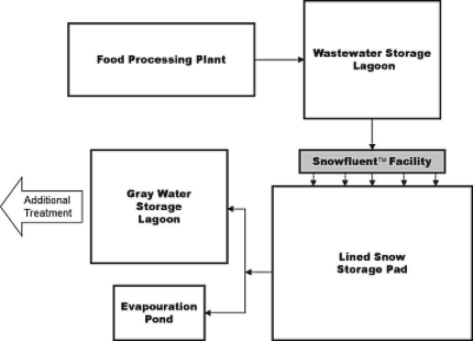| | Suggested guidelines for the use of Snowfluent | Snowfluent as a pretreatment of effluents unsuitable for land application or conventional treatment
Suggested Guidelines for the Use of Snowfluent
Land application of wastewater that exceeds Alberta Environmental Protection’s draft Guidelines for Municipal Wastewater Irrigation, particularly soluble ions, pose risks to soil quality and groundwater quality regardless of whether the application system is summer irrigation or winter application with Snowfluent. Likewise, fields that do not meet the site criteria set out in the draft guidelines pose significant risk of negative impacts to soil and groundwater quality. Specific recommendations for the employment of Snowfluent in the treatment of wastewaters are listed below.
Site selection for land application through a Snowfluent system
- Field sites should meet Alberta Environmental Protection’s draft "Guidelines for Municipal Wastewater Irrigation" for soils criteria (chemistry, texture and depth to groundwater).
- Fields should have no off-site drainage.
- Alfalfa and water tolerant forages for low-lying areas in the field are suitable crops for Snowfluent land application systems.
Wastewater suitable for land application with Snowfluent
Raw wastewater should meet Alberta Environmental Protection’s draft "Guidelines for Municipal Wastewater Irrigation" for Electrical Conductivity and Sodium Adsorption Ratio. Wastewater that does not meet these criteria eventually will impact soil quality or groundwater quality. Other parameters such as Biochemical Oxygen Demand and Faecal Coliforms, which receive significant treatment during snowmaking and snowpack aging, can be permitted to exceed the irrigation guidelines in the raw wastewater, provided that the guidelines are met by the snow’s meltwater.
System management for land application of food processing wastewater
- Processing wastewater as soon as possible after it is produced may help reduce off-site odour events. Anaerobic decomposition under ice in secondary lagoons will produce odour; either at ice break-up in the spring or at snowmaking. Processing wastewater through a Snowfluent system with as short a storage time in lagoons as possible does not negate the need for odour treatment at the lagoons. However, it does provide an opportunity to divert significant volumes of wastewater directly to land application and minimize the time of anaerobic decomposition in lagoons.
- Application rates of water to cropland should not exceed crop uptake, after accounting for sublimation and evaporation losses of water during snowmaking and in the snowpack. Typically, thirty percent more water than crop uptake volumes can be applied with Snowfluent to a field to make up for these losses. While other areas in North America may be able to accommodate groundwater charging from snowmelt, Alberta’s soils and surficial geology make groundwater charging problematic from salinity and other groundwater chemistry concerns.
- The nutrients applied through a Snowfluent system should be in balance with the crop’s nutrient uptake.
- Operators should wear breathing protection when working in and around the snow plume.
Snowfluent as a Pretreatment of Effluents Unsuitable for Land Application or Conventional Treatment
Snowfluent processing can be employed in a manner that will significantly reduce nutrient loads and salt concentrations in the wastewater discharged, while reducing biological pathogens. Figure 6 is a schematic flow diagram of such a system. Wastewater is processed and the snow is stored in deep piles on a large lined, bermed pad. Initial meltwaters, which contain almost all of the soluble salt material of the wastewater, are collected in an evaporation cell. Later meltwater, depleted of soluble salts and the less-soluble material that form a residue, can then be treated using appropriate conventional means. The residue, which is rich in plant nutrients, can be land applied as a fertilizer.

Figure 6. Flow diagram for Snowfluent processing for wastewaters not suitable for land application or conventional treatment
|
|